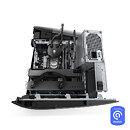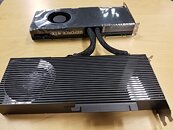Monday, May 18th 2020

Asetek Unveils Rad Card Industry's First Slot-In PCIe Radiator Card
Asetek, the creator of the all-in-one (AIO) liquid cooler and the global leader in liquid cooling solutions for gaming PCs and DIY enthusiasts, today announced its Rad Card GPU Cooler, bringing liquid cooled GPUs to space constrained PC cases. Asetek's Rad Card GPU Cooler, the industry's first slot-in PCIe radiator card, is first available in Dell-Alienware's newly introduced Alienware Aurora R11 PC.
Space concerns are a real issue for PC manufacturers, leaving GPU air cooling as the only option, until now. Asetek took this challenge head-on, innovating a new approach to radiator technology that reimagines the shape and location of the radiator. The Asetek Rad Card GPU Cooler fits into your motherboard's PCIe slot, just like any other add-in card. By utilizing PCIe slots, Asetek has defined a way to overcome PC manufacturers' dilemma of finding additional space inside the case for a liquid cooled GPU heat exchanger (HEx).
Update May 18th: This card may not be limited to just OEMs with Asetek tweeting "Not all of them made it to Alienware. Not what to do with these...". Asetek is very open about seeking feedback and is watching demand for this product from consumers, possibly even getting ready for a giveaway so it will be exciting to see what comes from this.The unique design of Asetek's Rad Card GPU Cooler provides numerous benefits:
Sources:
Asetek, @Asetek
Space concerns are a real issue for PC manufacturers, leaving GPU air cooling as the only option, until now. Asetek took this challenge head-on, innovating a new approach to radiator technology that reimagines the shape and location of the radiator. The Asetek Rad Card GPU Cooler fits into your motherboard's PCIe slot, just like any other add-in card. By utilizing PCIe slots, Asetek has defined a way to overcome PC manufacturers' dilemma of finding additional space inside the case for a liquid cooled GPU heat exchanger (HEx).
Update May 18th: This card may not be limited to just OEMs with Asetek tweeting "Not all of them made it to Alienware. Not what to do with these...". Asetek is very open about seeking feedback and is watching demand for this product from consumers, possibly even getting ready for a giveaway so it will be exciting to see what comes from this.The unique design of Asetek's Rad Card GPU Cooler provides numerous benefits:
- Space: Rad Card enables a liquid cooled GPU in a chassis where space is constrained, while leaving room for a liquid cooled CPU in the same case.
- Performance: In space constrained PC cases, Rad Card provides superior cooling over an air-cooled GPU, ensuring GPU stability and limiting thermal throttling.
- Aesthetics: Rad Card eliminates the hassle and clutter of tube routing for a clean and sparse system environment.




59 Comments on Asetek Unveils Rad Card Industry's First Slot-In PCIe Radiator Card
btw only ATX boards have 5+ slots
The DIY market reacted with absolute hatred and... BTX is basically only OEM and uncommon.
ATX lives on... :laugh:
Still, without a NB/SB, with most users only needing one (really, zero) expansion slots, where most desktop users who do need those slots only really need cooling for 2 of those devices, where desktops are becoming obsolete for most of the market, where itx and ribbon cables are the l33t thing now, etc, we could really be doing better for cooling (and probably integrated devices, but I don’t know anything about that).
And of course lack of a wide selection of compelling compatible cases would make adoption of the motherboards near nonexistent, meaning the cases wouldn't sell, meaning even fewer people would buy the cases... and there you have what happened to BTX.
The good thing about all this is that an ATX replacement is largely unnecessary these days. ITX is compatible and sufficient for >99% of PCs out there, and its smaller size allows for more varied case designs and form factors. A possible improvement would be some sort of mix of DTX and mATX to allow for four RAM slots and two PCIe while allowing for smaller cases than mATX, though I highly doubt anything like that will ever happen given that it would be a niche market competing with three well established alternatives.
In theory, my ideea mITX case is as small as reasonably possible to accommodate an mITX boad and top-flow air cooler, an SFX PSU and a typical 10.5" dual-slot GPU. Given the height of a PCIe card, it's pretty much guaranteed to also have space for a 3.5" or a couple of 2.5" drives too.